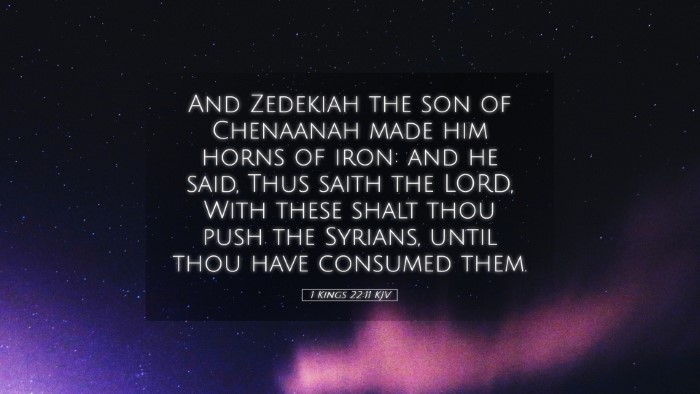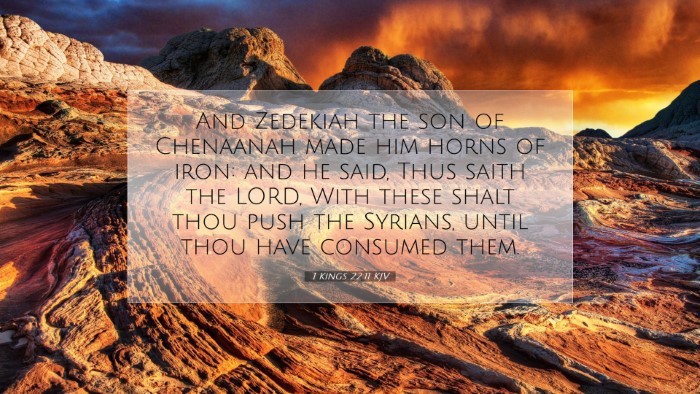Commentary on 1 Kings 22:11
This verse describes a significant moment in the narrative of the divided kingdom of Israel and Judah, where King Ahab of Israel seeks counsel from the prophets about a campaign against Ramoth-Gilead. The verse reads:
“And Zedekiah the son of Chenaanah made him horns of iron: and he said, Thus saith the LORD, With these thou shalt push the Syrians, until thou have consumed them.” (1 Kings 22:11, KJV)
Contextual Background
The context of this verse is critical for understanding its implications. King Ahab, facing military challenges, turns to a group of prophets for direction. This scenario reveals the political dynamics of the time, where prophets often provided guidance to kings, influencing their decisions regarding military campaigns.
Analysis of Key Figures
- King Ahab: Known for his complicated reign, Ahab was a king who often sought the advice of prophets. However, his relationship with the prophetic community was not always aligned with true worship of Yahweh, as evidenced by his alliances with foreign powers.
- Zedekiah son of Chenaanah: Zedekiah emerges as a prominent figure among the prophets, demonstrating a theatrical and dramatic approach to prophesying. His use of iron horns is symbolic and embodies the confidence that he and the other court prophets share in Ahab's campaign.
Theological Insights
This episode raises fundamental theological questions about the nature of prophecy and divine guidance. The use of props, such as horns of iron, suggests an attempt to convey certainty in the success of Ahab's plans. Yet, biblical scholarship often highlights the divergence between true prophecy and self-proclaimed prophets serving political interests.
Insights from Public Domain Commentaries
Matthew Henry’s Commentary
Henry emphasizes the theatrical display by Zedekiah, illustrating that the prophets’ visions were often dramatized. He argues that this action reveals the vacuity of such prophecies, indicating that the true spirit of prophecy lies beyond mere physical demonstrations. Henry notes that God’s true prophets would not need to resort to such theatrics to convey His message.
Albert Barnes’ Notes
Barnes elaborates on the significance of the horns as a symbolic representation of strength and conquest. He posits that Zedekiah’s declaration reflects typical prophetic embellishments of the time but contrasts this with the eventual condemnation that true prophets experience for failing to deliver an unambiguous message from God. Barnes highlights the ironic situation where Ahab chooses to listen to the false prophets rather than the conflicted truth that Micaiah would later present.
Adam Clarke’s Commentary
Clarke provides a historical perspective on the character of Zedekiah and the broader implications of his prophetic actions. He asserts that Zedekiah’s actions are indicative of a larger prophetic culture that had strayed from fidelity to God’s word. Clarke argues that while the king may be swayed by such dramatic displays, true discernment comes from a close relationship with God and an understanding of His will, which is absent in Ahab’s decision-making process.
Practical Applications for Ministry and Scholarship
For pastors, students, theologians, and Bible scholars, 1 Kings 22:11 provides rich material for exploration of the themes of leadership, accountability, and the integrity of prophetic ministry. In their pastoral practice, leaders must be wary of the seductive nature of popular opinion and dramatic displays of confidence that may lead them astray.
Questions for Reflection
- How can we discern between true and false prophecies in contemporary ministry?
- What does the behavior of Ahab and the prophets teach us about the nature of authority and the responsibility of leaders in seeking divine guidance?
- In what ways do we use symbols in our worship today, and how do they reflect our understanding of God's leading?
Conclusion
In conclusion, 1 Kings 22:11 is not merely a historical account but serves as a cautionary tale about the dangers of self-deception and the need for true prophetic voices. The interaction between Ahab and Zedekiah, while dramatic, calls us to examine our own pursuits for guidance and the sources we choose to trust. The insights from Henry, Barnes, and Clarke enrich our understanding and challenge us to seek authenticity in our spiritual journeys.


